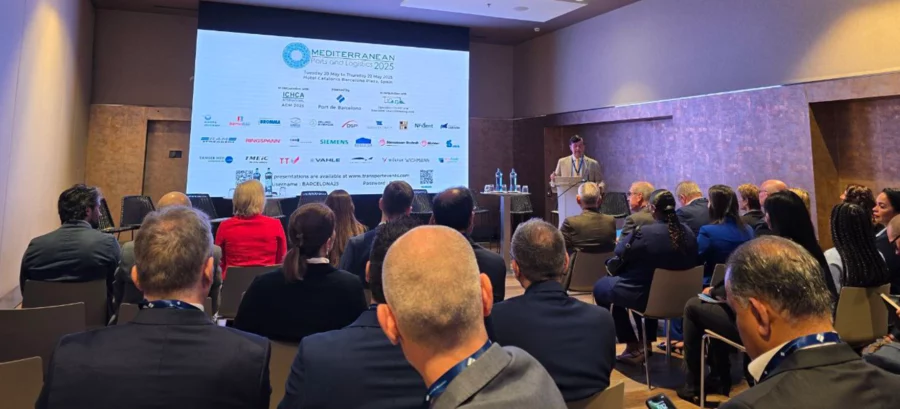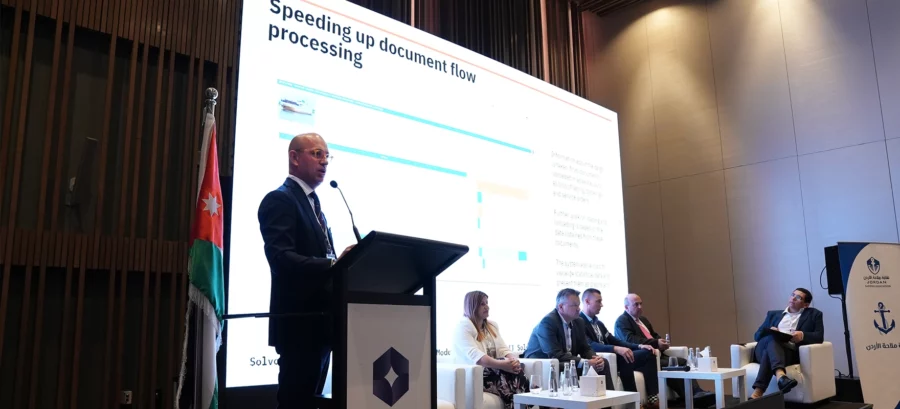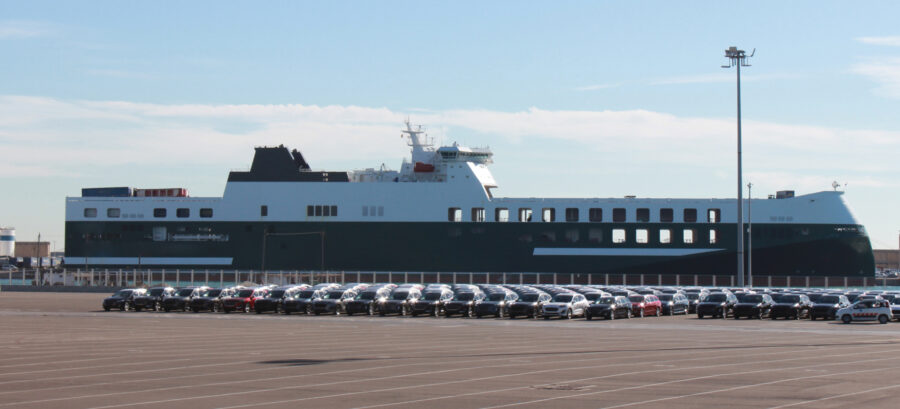Upgrading deeply embedded business processes that have been refined over years of operation is no easy task. How can this transition be made as smooth and seamless as possible? At Solvo, we know from experience that a combination of industry expertise and well-coordinated teamwork leads to outstanding results.
One of our most notable TOS upgrade projects last year took place at a major seaport terminal in the Baltic Sea. This facility handles and stores all types of container and general cargo across sea, road, and rail transport. The terminal’s scale is impressive — here are some key figures:
- Total area: 162 acres, with 3.3 miles of railway frontage
- Berthing capacity: Five berths totaling 0.7 miles, accommodating vessels up to 993 feet long
- Container yard capacity: 25,000 TEUs, enabling the terminal to process up to 1 million TEUs annually
A Long-Term Partnership
Since its establishment in 2011, the terminal has been operating with Solvo.TOS, which was successfully integrated into its business processes. At the time, Solvo.TOS v4 was the most advanced version, offering two key functional blocks:
- Container terminal operations management
- Document management
The implementation of Solvo.TOS v4 automated 69 business processes in total. Over the next decade, the terminal’s team focused on enhancing existing functionality, developing additional modules, and integrating various systems into the terminal’s IT infrastructure.
However, as the business grew, the terminal encountered natural limitations that restricted further development. Solvo.TOS v4 lacked the ability to manage diverse cargo types and support multimodal operations. Additionally, developing the necessary competitive modules in-house would have required substantial time and financial investment.
To support long-term growth and efficiency, the company decided to upgrade to the latest version of Solvo.TOS in 2023. According to internal assessments, the upgrade would significantly reduce operating costs over the next five years. The project was led by the terminal’s COO, with key stakeholders setting clear goals for a smooth and effective transition.
Project Goals
The upgrade to Solvo.TOS v7, the latest version of the system, aimed to bring both qualitative improvements to business processes and quantifiable operational benefits.
Qualitative improvements:
- Future-ready for seamless integration of additional modules and functionalities
- Enhanced adaptability for handling a wider range of cargo types
- Increased flexibility with the option to switch to a different DBMS
Quantifiable benefits:
- Lower technical support costs over the next five years
- Reduced expenses and time required for implementing system modifications
- Decreased workload across business processes
Five Key Objectives
Before the project began, five key objectives were identified:
- Implement new TOS functionality to provide a competitive edge and increase automation levels:
-
-
- Processing land container imports
- Managing empty container operations
- Handling electronic railway documentation within TOS
- Enabling seamless integration between TOS and the Client’s Personal Account on the terminal’s web portal
- Supporting general cargo operations
-
- Reduce the total cost of ownership over a period of at least five years.
- Switch smoothly to another DBMS.
- Automate routine operations to decrease workload.
- Reduce human error by minimizing manual data entry mistakes and improving data accuracy and reporting quality.
A critical part of the transition to Solvo.TOS v7 was preserving 13 years of historical data—amounting to 1.5 TB—while ensuring a seamless decommissioning of Solvo.TOS v4. The entire upgrade had to be executed without disrupting ongoing terminal operations.
Project Execution
At the start of the project, the system’s target functionality was divided into two categories:
- Existing business processes developed over 13 years of working with the previous TOS version.
- New functionality required for implementation as part of the upgrade.
The project took approximately 12 months, from its launch in December 2022 to the full deployment of the new platform in November 2023. During this time, the existing functionality was successfully adapted to the new Solvo.TOS v7, system architecture was configured, testing and data migration were completed. The final two months focused on system adaptation and stabilization before going live.
Seamless Data Migration
The migration of 13 years’ worth of historical data from Solvo.TOS 4 to Solvo.TOS 7 had to be executed on the fly, without disrupting terminal operations. At the same time, all existing processes needed to be precisely replicated to prevent failures.
The potential risk and cost of errors were high:
- At least 100 employees actively work in the TOS system simultaneously, alongside 150 equipment operating on the platform.
- Every day, 500–600 clients conduct transactions via the Client’s Personal Account on the terminal’s website, integrated with Solvo.TOS. Users issue vehicle visit requests, schedule inspections, sign procurations, exchange workingorders, and more.
A system failure during the transition could halt terminal entry and fleet processing, leading to significant financial losses and inevitable SLA violations.
How to Avoid Failures?
To mitigate operational risks, an additional system was deployed to fully mirror the existing environment, essentially creating a parallel architecture loaded with all terminal data. This duplicate platform served as a safe testing environment for core system functions and external devices such as radio data terminals, kiosks, and scales.
Since low-level business process details only surface when the system is live, the terminal’s key operations—such as full ship unloading—and activities within the Client’s Personal Account were meticulously tested step by step using this duplicate platform.
“Creating a duplicate architecture and testing it for stability is an optional but invaluable step — it ensures system reliability after the transition. When migrating large volumes of data, the system needs time to adjust. Meanwhile, cargo transactions in the new TOS must proceed immediately — within a single day. In real-time environments, rolling back is no longer an option, and automatic data consistency would be lost.”
— CIO of the terminal.
To validate the new architecture, detailed step-by-step testing scenarios were developed in collaboration with the terminal’s business team. Each step was carefully executed and verified by logistics specialists, eliminating over 95% of potential discrepancies in system behavior.
Outcome
As a result, the TOS transition was completed successfully:
- Zero data loss
- Full existing functionality migration
- No loss or degradation of automation
Results
1. Seamless Existing Functionality Migration
The transfer of historical data and already automated business processes was completed smoothly and without disruption.
2. Implementation of New Functionality
The new version of Solvo.TOS introduced strategically important features to support long-term TOS development and enable future migration to another DBMS, including:
- Processing of transit land container imports
- Creation of a consolidated monthly fleet processing schedule with berth reservations for each vessel call
- Seamless integration with the railway information system, allowing users to submit cargo transportation requests and track their status directly in TOS
3. Reduced Total Cost of Ownership
- Optimized virtualization has reduced the need for additional hardware, lowering purchasing and maintenance costs. The price of radio data terminals has dropped by 2.5 times.
- The new technology stack enables faster and more cost-effective implementation of new features and enhancements.
- The introduction of the “One-Stop Shop” system and automated data exchange between TOS and the Client’s Personal Account has significantly reduced manual data entry errors, leading to fewer support requests.
- A new version of the mobile application, integrated with TOS, has replaced paper-based delivery order processing with electronic workflows. More than 55-60% of drivers now use the app to schedule visits, reducing operating and printing costs.
4. Workforce Optimization Through Automation
By automating labor-intensive operations, workforce resources at the terminal were successfully redistributed. With the updated mobile application, the guaranteed driver service time at the terminal has been reduced to 40 minutes.
5. Enhanced Information Security
The addition of an extra software security layer between the terminal portal and Solvo.TOS 7 has further strengthened data protection.
What’s Next?
Looking ahead, Solvo and the terminal plan to further enhance automation, optimize equipment and workforce management, and continue developing the mobile application to improve efficiency and user experience.






